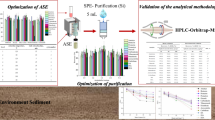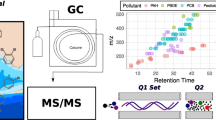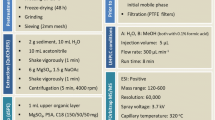Abstract
Previous studies on organic sediment contaminants focused mainly on a limited number of highly hydrophobic micropollutants accessible to gas chromatography using nonpolar, aprotic extraction solvents. The development of liquid chromatography–high-resolution mass spectrometry (LC–HRMS) permits the spectrum of analysis to be expanded to a wider range of more polar and ionic compounds present in sediments and allows target, suspect, and nontarget screening to be conducted with high sensitivity and selectivity. In this study, we propose a comprehensive multitarget extraction and sample preparation method for characterization of sediment pollution covering a broad range of physicochemical properties that is suitable for LC–HRMS screening analysis. We optimized pressurized liquid extraction, cleanup, and sample dilution for a target list of 310 compounds. Finally, the method was tested on sediment samples from a small river and its tributaries. The results show that the combination of 100 °C for ethyl acetate–acetone (50:50, neutral extract) followed by 80 °C for acetone–formic acid (100:1, acidic extract) and methanol–10 mM sodium tetraborate in water (90:10, basic extract) offered the best extraction recoveries for 287 of 310 compounds. At a spiking level of 1 μg mL-1, we obtained satisfactory cleanup recoveries for the neutral extract—(93 ± 23)%—and for the combined acidic/basic extracts—(42 ± 16)%—after solvent exchange. Among the 69 compounds detected in environmental samples, we successfully quantified several pharmaceuticals and polar pesticides.




Similar content being viewed by others
References
Brack W, Ait-Aissa S, Burgess RM, Busch W, Creusot N, Di Paolo C, et al. Effect-directed analysis supporting monitoring of aquatic environments — an in-depth overview. Sci The Total Environ. 2016;544:1073–118. https://doi.org/10.1016/j.scitotenv.2015.11.102.
Schwarzenbach RP, Escher BI, Fenner K, Hofstetter TB, Johnson CA, von Gunten U, et al. The challenge of micropollutants in aquatic systems. Science. 2006;313(5790):1072–7. https://doi.org/10.1126/science.1127291.
Soclo HH, Garrigues P, Ewald M. Origin of polycyclic aromatic hydrocarbons (PAHs) in coastal marine sediments: case Sstudies in Cotonou (Benin) and Aquitaine (France) areas. Mar Pollut Bull. 2000;40(5):387–96. https://doi.org/10.1016/S0025-326X(99)00200-3.
Qiao M, Wang C, Huang S, Wang D, Wang Z. Composition, sources, and potential toxicological significance of PAHs in the surface sediments of the Meiliang Bay, Taihu Lake, China. Environ Int. 2006;32(1):28–33. https://doi.org/10.1016/j.envint.2005.04.005.
Ma M, Feng Z, Guan C, Ma Y, Xu H, Li H. DDT, PAH and PCB in sediments from the intertidal zone of the Bohai Sea and the Yellow Sea. Mar Pollut Bull. 2001;42(2):132–6. https://doi.org/10.1016/S0025-326X(00)00118-1.
Vazquez-Roig P, Segarra R, Blasco C, Andreu V, Picó Y. Determination of pharmaceuticals in soils and sediments by pressurized liquid extraction and liquid chromatography tandem mass spectrometry. J Chromatogr A. 2010;1217(16):2471–83. https://doi.org/10.1016/j.chroma.2009.11.033.
Vazquez-Roig P, Andreu V, Blasco C, Picó Y. Risk assessment on the presence of pharmaceuticals in sediments, soils and waters of the Pego–Oliva Marshlands (Valencia, eastern Spain). Sci Total Environ. 2012;440:24–32. https://doi.org/10.1016/j.scitotenv.2012.08.036.
Löffler D, Ternes TA. Determination of acidic pharmaceuticals, antibiotics and ivermectin in river sediment using liquid chromatography–tandem mass spectrometry. J Chromatogr A. 2003;1021(1–2):133–44. https://doi.org/10.1016/j.chroma.2003.08.089.
Yamamoto H, Nakamura Y, Moriguchi S, Nakamura Y, Honda Y, Tamura I, et al. Persistence and partitioning of eight selected pharmaceuticals in the aquatic environment: laboratory photolysis, biodegradation, and sorption experiments. Water Res. 2009;43(2):351–62.
Camusso M, Galassi S, Vignati D. Assessment of river Po sediment quality by micropollutant analysis. Water Res. 2002;36(10):2491–504. https://doi.org/10.1016/S0043-1354(01)00485-7.
Guzzella L, Roscioli C, Viganò L, Saha M, Sarkar SK, Bhattacharya A. Evaluation of the concentration of HCH, DDT, HCB, PCB and PAH in the sediments along the lower stretch of Hugli estuary, West Bengal, northeast India. Environ Int. 2005;31(4):523–34. https://doi.org/10.1016/j.envint.2004.10.014.
Camino-Sánchez FJ, Zafra-Gómez A, Pérez-Trujillo JP, Conde-González JE, Marques JC, Vílchez JL. Validation of a GC–MS/MS method for simultaneous determination of 86 persistent organic pollutants in marine sediments by pressurized liquid extraction followed by stir bar sorptive extraction. Chemosphere. 2011;84(7):869–81. https://doi.org/10.1016/j.chemosphere.2011.06.019.
Björklund E, Nilsson T, Bøwadt S. Pressurised liquid extraction of persistent organic pollutants in environmental analysis. Trends Anal Chem. 2000;19(7):434–45. https://doi.org/10.1016/S0165-9936(00)00002-9.
Lopez-Avila V, Young R, Beckert WF. Microwave-assisted extraction of organic compounds from standard reference soils and sediments. Anal Chem. 1994;66(7):1097–106.
Martinez E, Gros M, Lacorte S, Barceló D. Simplified procedures for the analysis of polycyclic aromatic hydrocarbons in water, sediments and mussels. J Chromatogr A. 2004;1047(2):181–8. https://doi.org/10.1016/j.chroma.2004.07.003.
Ramos L, Vreuls J, Brinkman UT. Miniaturised pressurised liquid extraction of polycyclic aromatic hydrocarbons from soil and sediment with subsequent large-volume injection–gas chromatography. J Chromatogr A. 2000;891(2):275–86.
Chee KK, Wong MK, Lee HK. Optimization of microwave-assisted solvent extraction of polycyclic aromatic hydrocarbons in marine sediments using a microwave extraction system with high-performance liquid chromatography-fluorescence detection and gas chromatography-mass spectrometry. J Chromatogr A. 1996;723(2):259–71.
Liu D, Wong P, Dutka B. Determination of carbohydrate in lake sediment by a modified phenol-sulfuric acid method. Water Res. 1973;7(5):741–6.
Schwarzbauer J, Ricking M, Franke S, Francke W. Halogenated organic contaminants in sediments of the Havel and Spree rivers (Germany). Part 5 of organic compounds as contaminants of the Elbe River and its tributaries. Environ Sci Technol. 2001;35(20):4015–25. https://doi.org/10.1021/es010084r.
Franke S, Schwarzbauer J, Francke W. Arylesters of alkylsulfonic acids in sediments. Part III of organic compounds as contaminants of the Elbe River and its tributaries. Fresenius J Anal Chem. 1998;360(5):580–8. https://doi.org/10.1007/s002160050762.
Ricking M, Schwarzbauer J, Franke S. Molecular markers of anthropogenic activity in sediments of the Havel and Spree rivers (Germany). Water Res. 2003;37(11):2607–17. https://doi.org/10.1016/S0043-1354(03)00078-2.
Pérez-Carrera E, Hansen M, León VM, Björklund E, Krogh KA, Halling-Sørensen B, et al. Multiresidue method for the determination of 32 human and veterinary pharmaceuticals in soil and sediment by pressurized-liquid extraction and LC-MS/MS. Anal Bioanal Chem. 2010;398(3):1173–84. https://doi.org/10.1007/s00216-010-3862-x.
Jelić A, Petrović M, Barceló D. Multi-residue method for trace level determination of pharmaceuticals in solid samples using pressurized liquid extraction followed by liquid chromatography/quadrupole-linear ion trap mass spectrometry. Talanta. 2009;80(1):363–71.
Chiaia-Hernandez AC, Krauss M, Hollender J. Screening of lake sediments for emerging contaminants by liquid chromatography atmospheric pressure photoionization and electrospray ionization coupled to high resolution mass spectrometry. Environ Sci Technol. 2013;47(2):976–86. https://doi.org/10.1021/es303888v.
Minten J, Adolfsson-Erici M, Alsberg T. Extraction and analysis of pharmaceuticals in polluted sediment using liquid chromatography mass spectrometry. International J Environ Anal Chem. 2011;91(6):553–66. https://doi.org/10.1080/03067311003657983.
Hajj-Mohamad M, Aboulfadl K, Darwano H, Madoux-Humery A-S, Guérineau H, Sauvé S, et al. Wastewater micropollutants as tracers of sewage contamination: analysis of combined sewer overflow and stream sediments. Environ Sci Process Impacts. 2014;16(10):2442–50.
Varga M, Dobor J, Helenkár A, Jurecska L, Yao J, Záray G. Investigation of acidic pharmaceuticals in river water and sediment by microwave-assisted extraction and gas chromatography–mass spectrometry. Microchem J. 2010;95(2):353–8. https://doi.org/10.1016/j.microc.2010.02.010.
US EPA. Method 1694: pharmaceuticals and personal care products in water, soil, sediment, and biosolids by HPLC/MS/MS. 2007.
Krauss M, Singer H, Hollender J. LC–high resolution MS in environmental analysis: from target screening to the identification of unknowns. Anal Bioanal Chem. 2010;397(3):943–51. https://doi.org/10.1007/s00216-010-3608-9.
Hug C, Ulrich N, Schulze T, Brack W, Krauss M. Identification of novel micropollutants in wastewater by a combination of suspect and nontarget screening. Environ Pollut. 2014;184:25–32. https://doi.org/10.1016/j.envpol.2013.07.048.
Greulich K, Alder L. Fast multiresidue screening of 300 pesticides in water for human consumption by LC-MS/MS. Anal Bioanal Chem. 2008;391(1):183–97. https://doi.org/10.1007/s00216-008-1935-x.
Nogueira JMF, Sandra T, Sandra P. Multiresidue screening of neutral pesticides in water samples by high performance liquid chromatography–electrospray mass spectrometry. Anal Chim Acta. 2004;505(2):209–15. https://doi.org/10.1016/j.aca.2003.10.065.
Hernández F, Pozo ÓJ, Sancho JV, López FJ, Marín JM, Ibáñez M. Strategies for quantification and confirmation of multi-class polar pesticides and transformation products in water by LC–MS2 using triple quadrupole and hybrid quadrupole time-of-flight analyzers. Trends Anal Chem. 2005;24(7):596–612. https://doi.org/10.1016/j.trac.2005.04.007.
Schymanski EL, Singer HP, Longrée P, Loos M, Ruff M, Stravs MA, et al. Strategies to characterize polar organic contamination in wastewater: exploring the capability of high resolution mass spectrometry. Environ Sci Technol. 2014;48(3):1811–8.
Chiaia-Hernandez AC, Schymanski EL, Kumar P, Singer HP, Hollender J. Suspect and nontarget screening approaches to identify organic contaminant records in lake sediments. Anal Bioanal Chem. 2014;406(28):7323–35.
Radjenović J, Jelić A, Petrović M, Barceló D. Determination of pharmaceuticals in sewage sludge by pressurized liquid extraction (PLE) coupled to liquid chromatography-tandem mass spectrometry (LC-MS/MS). Anal Bioanal Chem. 2009;393(6):1685–95. https://doi.org/10.1007/s00216-009-2604-4.
US EPA. Definition and procedure for the determination of the method detection limit. 40 CFR Part 136, Appendix B to Part 136 Revision 1.11. 2011.
Richter BE, Jones BA, Ezzell JL, Porter NL, Avdalovic N, Pohl C. Accelerated solvent extraction: a technique for sample preparation. Anal Chem. 1996;68(6):1033–9. https://doi.org/10.1021/ac9508199.
Müller T, Rosendahl I, Focks A, Siemens J, Klasmeier J, Matthies M. Short-term extractability of sulfadiazine after application to soils. Environ Pollut. 2013;172:180–5.
Lee LS, Nyman AK, Li H, Nyman MC, Jafvert C. Initial sorption of aromatic amines to surface soils. Environm Toxicol Chem. 1997;16(8):1575–82.
Weber EJ, Colón D, Baughman GL. Sediment-associated reactions of aromatic amines. 1. Elucidation of sorption mechanisms. Environ Sci Technol. 2001;35(12):2470–5.
Berlioz-Barbier A, Vauchez A, Wiest L, Baudot R, Vulliet E, Cren-Olivé C. Multi-residue analysis of emerging pollutants in sediment using QuEChERS-based extraction followed by LC-MS/MS analysis. Anal Bioanal Chem. 2014;406(4):1259–66. https://doi.org/10.1007/s00216-013-7450-8.
Langford KH, Reid M, Thomas KV. Multi-residue screening of prioritised human pharmaceuticals, illicit drugs and bactericides in sediments and sludge. J Environ Monit. 2011;13(8):2284–91.
Reid BJ, Jones KC, Semple KT. Bioavailability of persistent organic pollutants in soils and sediments—a perspective on mechanisms, consequences and assessment. Environ Pollut. 2000;108(1):103–12. https://doi.org/10.1016/S0269-7491(99)00206-7.
Inostroza PA, Massei R, Wild R, Krauss M, Brack W (2017) Chemical activity and distribution of emerging pollutants: Insights from a multi-compartment analysis of a freshwater system. Environ. Pollut. 2017:231(Pt 1):339-347. https;://doi.org/10.1016/j.envpol.2017.08.015
Wu Q, Riise G, Pflugmacher S, Greulich K, Steinberg CEW. Combined effects of the fungicide propiconazole and agricultural runoff sediments on the aquatic bryophyte Vesicularia dubyana. Environ Toxicol Chem. 2005;24(9):2285–90. https://doi.org/10.1897/04-364R.1.
Dong S, Huang G, Lu J, Huang T. Determination of fungicides in sediments using a dispersive liquid–liquid microextraction procedure based on solidification of floating organic drop. J Sep Sci. 2014;37(11):1337–42. https://doi.org/10.1002/jssc.201400010.
Kvíčalová M, Doubravová P, Jobánek R, Jokešová M, Očenášková V, Süssenbeková H, et al. Application of different extraction methods for the determination of selected pesticide residues in sediments. Bull Environ Contam Toxicol. 2012;89(1):21–6. https://doi.org/10.1007/s00128-012-0622-y.
Acknowledgements
We thank Jörg Ahlheim and Pedro Inostroza for sample collection. We also thank Melis Muz for reviewing the draft versions. We acknowledge funding by the SOLUTIONS Project supported by the European Union Seventh Framework Programme (FP7-ENV-2013-two-stage collaborative project) under grant agreement no. 603437. Chemaxon (Budapest, Hungary) is gratefully acknowledged for free academic licenses for Marvin and JChem for Excel.
Author information
Authors and Affiliations
Corresponding author
Ethics declarations
The study was partly founded by the SOLUTIONS project supported by the European Union’s Seventh Framework Programme (FP7-ENV-2013-two-stage Collaborative project) under grant agreement no. 603437. The authors declare that they have no conflict of interest. This study does not contain any studies with human participants or animals performed by any of the authors. Additional informed consent was obtained from all individual participants for whom identifying information is included in this study.
Rights and permissions
About this article
Cite this article
Massei, R., Byers, H., Beckers, LM. et al. A sediment extraction and cleanup method for wide-scope multitarget screening by liquid chromatography–high-resolution mass spectrometry. Anal Bioanal Chem 410, 177–188 (2018). https://doi.org/10.1007/s00216-017-0708-9
Received:
Revised:
Accepted:
Published:
Issue Date:
DOI: https://doi.org/10.1007/s00216-017-0708-9




